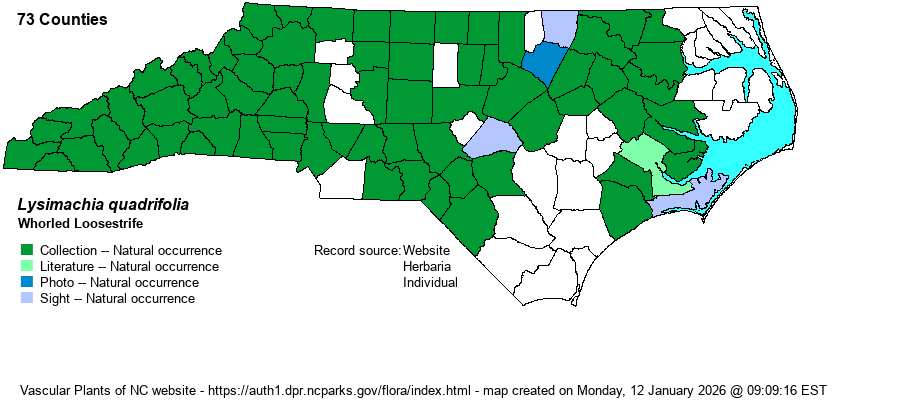| Author | L. | |
| Distribution | Throughout the Mountains, Piedmont, and the northern and central Coastal Plain, being absent only from northeastern counties and a few in the far southeast.
This is a widespread Northern species, ranging from eastern Canada south to southern SC and central AL. | |
| Abundance | Common in the Mountains and foothills; fairly common in most of the Piedmont, but uncommon in the southern counties and the far northeastern Piedmont. Infrequent in the northwestern Coastal Plain as well as in the Sandhills region; rare to uncommon south to Onslow and Robeson counties. | |
| Habitat | This is a species of a great array of habitats, but most are dry to mesic. In inhabits open upland woods, wooded borders, roadbanks, pine/scrub oak sandhills, powerline clearings, and thickets. It can be found in savannas and other moist places in the lower Coastal Plain. | |
| Phenology | Blooms from May to July, and fruits from August to October. | |
| Identification | This is a very familiar and easily identified wildflower, especially in the Mountains. It has an erect, rarely branched stem growing to about 2 feet tall, with numerous whorls of leaves. Each whorl usually has 4 leaves, each one being lancolate to narrowly ovate, about 3 inches long and about 3/4-inch wide. Unlike others in the genus, this odd species has a flower growing essentially at each leaf axil, meaning about 4 flowers at each whorl, each on a very long and slender pedicel about 1.5 inches in length. The yellow flowers are quite a bit smaller than others in the genus, with the 5 petals barely making the spread flower 1/2-inch across. It is rare to see a wildflower with yellow flowers completely up and down the stem of a plant like this one, and thus in bloom it is unmistakable. However, despite the whorl of usually 4 leaves, a few other species can be mistaken for it when not in bloom, such as Silene stellata. | |
| Taxonomic Comments | None
Weakley (2020) has split out Steironema from Lysimachia based on a 2018 paper using molecular research; and in so doing has gone back to "old" taxonomy. In Lysimachia there are no staminodes and the leaves are punctate with elongate markings (vs. staminodes present and punctae absent in Steironema). | |
| Other Common Name(s) | Whorled Yellow Loosestrife, Crosswort | |
| State Rank | S5 | |
| Global Rank | G5 | |
| State Status | | |
| US Status | | |
| USACE-agcp | FACU link |
| USACE-emp | FACU link |

